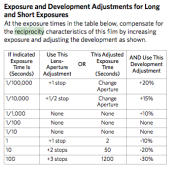It depends on what you are shooting with...I have gotten pretty good results with Ilford's 3200 Delta film, assuming they still make it. Kodak also had a similar film, but alas, I doubt it is available any longer. It also helps to have a camera with a visible meter display...such as the red LED inside a Nikon FM or a Mamiya 1000S...this way you can see where your exposure is at night. I've used a Nikon F3HP for some night work, but the meter display didn't light up on mine, so it was very difficult to tell the exposure...this also makes it difficult to use some of the old needle displays in Pentax SPs, etc. I would start very simple with 35mm or medium format and see how it works for you before diving into anything like 5x7 at night. I also tend to photograph in areas with at least some light, such as a downtown at night, gas stations, neon signs, industrial areas, neighborhoods, etc. I haven't had as much luck photographing in areas that are pitch black or nearly so because it is so hard to focus. In most cities and towns at night, there is usually just enough light to get an image in focus and to get a meter reading. I've also had pretty good luck with Fuji's 400 speed black and white film at night, but it does make for a longer exposure. The nice thing about shooting at night is that the exposure doesn't have to be terribly precise...the night is very compensating. Unless you are dealing with a well-lit shop window, or a neon sign, it is pretty hard to OVERexpose a nocturnal image. Underexposure is much more likely. Good night work: Brassai, Micheal Kenna, most of the work on The Nocturnes website. Good luck!







